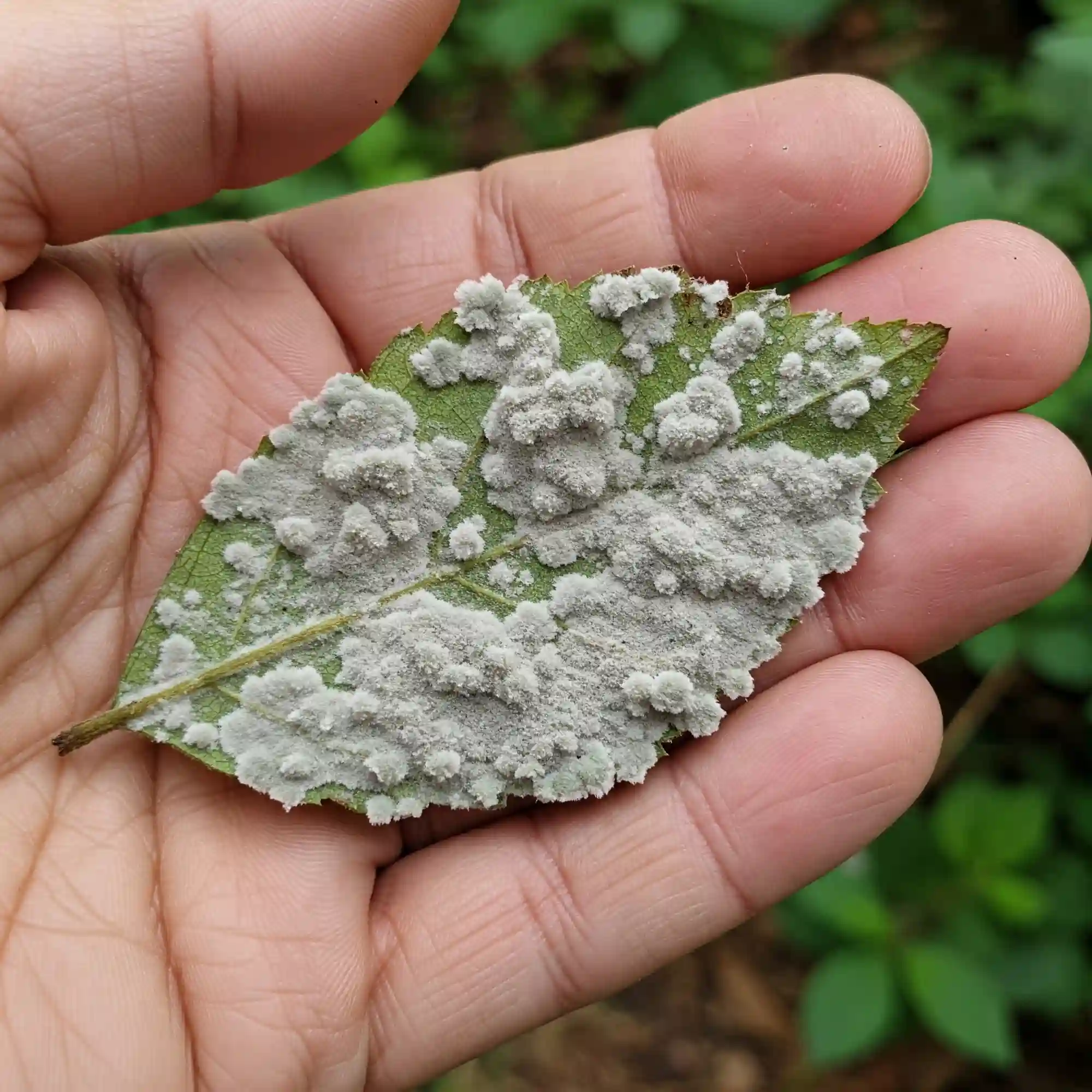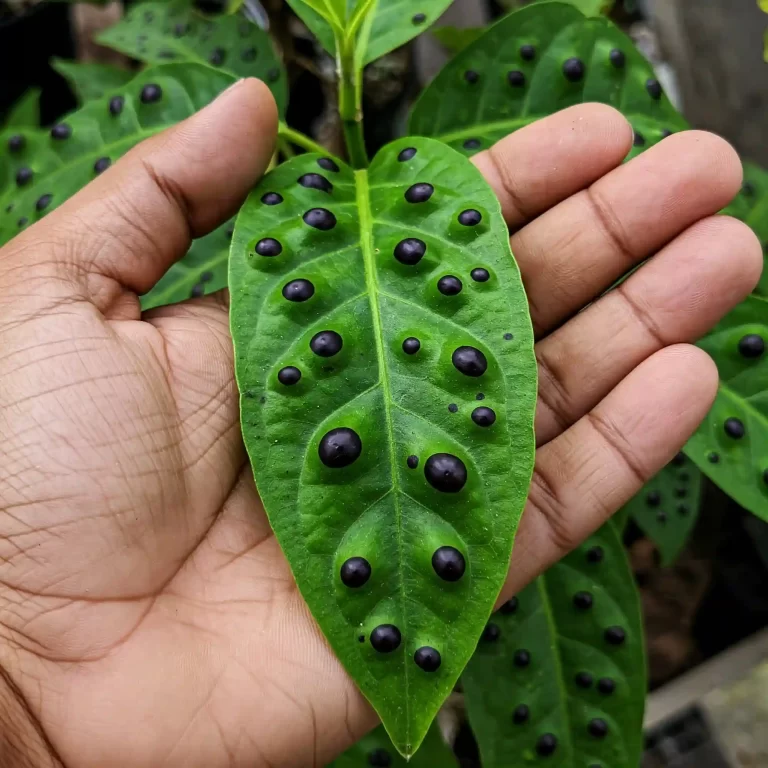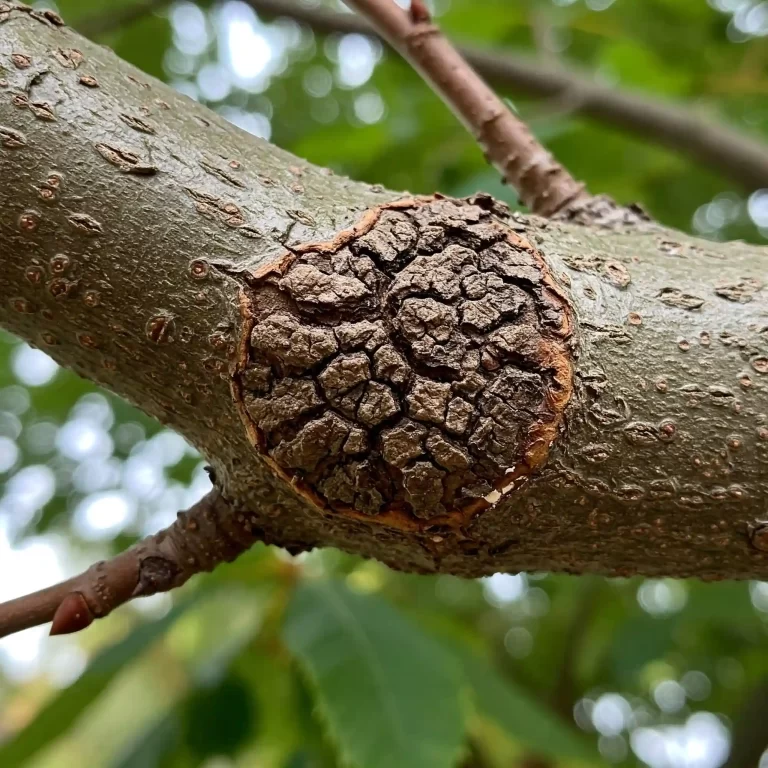Have you ever noticed a sudden, rapid decay on your prized squash or bean plants, with a fuzzy, gray mold creeping across the leaves and flowers? It’s a gut-wrenching sight, isn’t it? That’s likely the work of Choanephora blight, a fungal disease that can turn your garden dreams into a damp, decaying nightmare. You’re not alone in facing this challenge, and I’m here to guide you through understanding and managing this aggressive blight.
What Exactly is Choanephora Blight?
Choanephora blight is a devastating fungal disease that can quickly attack and destroy various plant species, particularly those in the cucurbit family, such as squash, cucumbers, and melons. The culprit behind this blight is the fungus Choanephora cucurbitarum, a pathogen that thrives in warm, humid conditions.
Understanding the Fungus
Choanephora cucurbitarum is a necrotrophic fungus, meaning it feeds on the dead tissues of its host plants. It produces a mass of thread-like structures called hyphae, which penetrate the plant’s tissues and release enzymes that break down the plant cells. This leads to the characteristic symptoms of Choanephora blight, such as water-soaked lesions, rapid decay, and the formation of a gray-white mold.
The Spread of Choanephora Blight
Choanephora blight primarily spreads through the movement of spores. These microscopic reproductive structures are easily dispersed by wind, water, and even insects. Once the spores land on a susceptible plant, they germinate and infect the plant tissues.
Plants Commonly Affected
While cucurbits are particularly vulnerable to Choanephora blight, the disease can also infect other plants, including:
- Beans: Both bush and pole beans can be affected.
- Peppers: Both sweet and hot peppers are susceptible.
- Eggplants: This vegetable can also be infected.
- Ornamentals: Some ornamental plants, such as zinnias and petunias, can also be affected.
It’s important to note that the severity of Choanephora blight can vary depending on several factors, including the specific plant species, environmental conditions, and the overall health of the plants.
Choanephora blight is a serious fungal disease that can cause significant damage to your garden. By understanding the nature of this pathogen and the factors that contribute to its spread, you can take proactive steps to protect your plants and minimize the impact of this devastating disease. In the following sections, we will delve deeper into recognizing the signs of Choanephora blight, creating an unfavorable environment for its development, and implementing effective control measures.
Recognizing the Signs of Choanephora Blight
Early detection is key to managing Choanephora blight effectively. By familiarizing yourself with the telltale signs of this disease, you can take swift action to protect your plants.
Visual Symptoms
Choanephora blight manifests in several distinct ways:
- Water-soaked Lesions: Keep a close eye on your plants for the appearance of water-soaked lesions on leaves, stems, and flowers. These lesions start small but can quickly expand, causing significant damage.
- Rapidly Spreading Gray-White Mold: One of the most characteristic symptoms of Choanephora blight is the rapid development of a fuzzy, gray-white mold. This mold often covers the infected areas, giving the plant a sickly appearance.
- Blossom Blight and Fruit Rot: Choanephora blight can severely impact the reproductive parts of the plant. Infected blossoms may fail to develop or may rot prematurely. Similarly, the fungus can cause fruit rot, rendering the produce inedible.
- Stunted Plant Growth: As the disease progresses, infected plants may exhibit stunted growth and overall decline in vigor. They may appear weak, wilted, and unable to thrive.
Importance of Early Detection
Early detection is crucial in managing Choanephora blight. The sooner you identify the disease, the more effectively you can implement control measures and minimize the damage to your plants. Regular monitoring of your garden is essential, especially during periods of high humidity and warm temperatures when the fungus thrives.
By carefully observing your plants for the characteristic symptoms of Choanephora blight, such as water-soaked lesions, gray-white mold, blossom blight, and stunted growth, you can take proactive steps to protect your garden. Early detection is key to successful management of this disease, allowing you to implement control measures promptly and minimize the impact on your plants.
Creating an Unfavorable Environment for Choanephora Blight
Choanephora blight thrives in warm, humid conditions. By creating an environment that is less conducive to the growth and spread of this fungus, you can significantly reduce the risk of infection. Here are some key strategies:
Proper Watering Techniques
- Water at the Base: One of the most important steps is to water your plants at the base, avoiding wetting the leaves and flowers. Wet foliage creates ideal conditions for fungal spores to germinate and infect the plant.
- Drip Irrigation: Consider using drip irrigation systems, which deliver water directly to the root zone, minimizing the amount of moisture on the plant’s foliage.
- Good Drainage: Ensure that your garden soil has good drainage to prevent waterlogging. Soggy soil can create a perpetually moist environment, favoring the growth of Choanephora blight.
Enhancing Air Circulation
- Spacing Plants: Proper spacing between plants allows for better air circulation, which helps to dry the foliage quickly after watering or rainfall. This reduced humidity discourages fungal growth.
- Pruning: Regular pruning can improve air circulation within the plant canopy, especially for bushy plants.
- Using Fans: In enclosed spaces like greenhouses or hoop houses, using fans can help to increase air movement and reduce humidity.
Sunlight and Temperature Management
- Adequate Sunlight: Ensure that your plants receive adequate sunlight. Sunlight helps to dry the foliage and can inhibit fungal growth.
- Temperature Management: While Choanephora blight thrives in warm temperatures, maintaining consistent temperatures can help to reduce the severity of outbreaks. Avoid sudden temperature fluctuations, as these can stress plants and make them more susceptible to infection.
By implementing these strategies, you can create a less hospitable environment for Choanephora blight and significantly reduce the risk of infection in your garden.
Cultural Practices for Choanephora Blight Management
In addition to modifying the environment, employing sound cultural practices can significantly reduce the incidence and severity of Choanephora blight. These practices focus on sanitation, crop rotation, and the selection of resistant varieties.
Sanitation
- Removing and Destroying Infected Plant Debris: Infected plant material should be removed from the garden and destroyed promptly. This prevents the fungus from overwintering in the soil or spreading to other plants.
- Sanitizing Tools and Equipment: It’s essential to sanitize tools and equipment that have come into contact with infected plants. This can be done by wiping them down with a solution of 10% bleach or isopropyl alcohol.
Crop Rotation
- Breaking the Disease Cycle: Crop rotation involves planting different crops in the same area each year. This helps to break the disease cycle by preventing the buildup of fungal spores in the soil.
- Suitable Rotation Partners: Choose crops that are not susceptible to Choanephora blight as rotation partners for cucurbits and other affected plants. For example, you could rotate to crops like lettuce, spinach, or root vegetables.
Resistant Varieties
- Selecting Disease-Resistant Varieties: Planting disease-resistant varieties of cucurbits and other susceptible crops can significantly reduce the risk of Choanephora blight infection.
- Availability and Selection: Research and select varieties that have been shown to exhibit some level of resistance to Choanephora blight.
By implementing these cultural practices, you can create a less favorable environment for the development and spread of Choanephora blight.
Natural and Organic Control Methods
While cultural practices and environmental management play a crucial role in preventing and managing Choanephora blight, there are also several natural and organic control methods you can employ. These methods offer a more environmentally friendly approach to managing this disease.
Neem Oil
- Neem oil is a natural plant extract derived from the neem tree. It has antifungal properties and can help to control the growth of Choanephora blight.
- Application: Neem oil can be applied to plants as a foliar spray. Follow the instructions on the product label carefully for proper dilution and application rates.
- Frequency of Application: Repeat applications may be necessary, especially during periods of high humidity or after heavy rainfall.
Baking Soda Spray
- Baking soda has antifungal properties and can be used to create a simple and effective homemade fungicide.
- Recipe: Mix 1 tablespoon of baking soda with 1 gallon of water and a few drops of liquid soap.
- Application: Spray the affected plants thoroughly, ensuring that the solution covers both the upper and lower surfaces of the leaves.
- Frequency of Application: Repeat applications may be necessary, especially during periods of high humidity or after heavy rainfall.
Biocontrol Agents
- Biocontrol agents are beneficial microorganisms that can help to suppress the growth of fungal pathogens.
- Types of Biocontrol Agents: Some examples of biocontrol agents that can be used to manage Choanephora blight include Trichoderma harzianum and Bacillus subtilis.
- Application: Biocontrol agents are typically applied as a soil drench or foliar spray.
It’s important to note that natural and organic control methods may not always provide complete control of Choanephora blight, especially during severe outbreaks. However, they can be effective in reducing the severity of the disease and minimizing the reliance on synthetic fungicides.
When to Use Chemical Controls
While natural and organic methods can be effective in managing Choanephora blight, there may be instances where chemical controls are necessary. Chemical fungicides should be considered as a last resort, especially if the disease is severe and threatens to cause significant crop loss.
Choosing the Right Fungicide
- Select Fungicides Specifically Labeled for Choanephora Blight: Choose fungicides that are specifically labeled for the control of Choanephora blight on the crops you are growing.
- Consider the Type of Fungicide: Different types of fungicides have different modes of action. Consider using fungicides with different modes of action to prevent the development of fungicide resistance.
- Consult with Local Experts: If you are unsure about which fungicide to use, consult with your local county extension office or a certified crop consultant.
Application and Safety
- Follow Label Instructions Carefully: Always follow the label instructions carefully regarding the application rate, timing, and safety precautions.
- Wear Appropriate Personal Protective Equipment (PPE): When applying chemical fungicides, always wear appropriate PPE, including gloves, long sleeves, and eye protection.
- Avoid Spraying During Windy Conditions: Avoid spraying fungicides during windy conditions to prevent drift and contamination of non-target areas.
- Apply Fungicides at the Right Time: Apply fungicides at the first sign of infection or as a preventative measure during periods of high humidity and warm temperatures.
Using Chemical Controls Responsibly
Chemical controls should always be used responsibly and as part of an integrated pest management (IPM) approach. This involves combining cultural practices, biological controls, and chemical controls to manage pests and diseases in a sustainable and effective manner.
Preventing Choanephora Blight in Your Garden
Prevention is always the best strategy when it comes to managing plant diseases. By taking proactive steps to minimize the risk of Choanephora blight, you can protect your garden and enjoy healthy, productive plants.
Starting with Healthy Plants
- Using Clean and Disease-Free Seeds and Transplants: Start with healthy plants by using clean, disease-free seeds and transplants. Avoid using seeds or transplants from infected plants.
- Inspecting Plants Before Planting: Carefully inspect plants before planting them in your garden. Look for any signs of disease, such as lesions or mold. Discard any plants that show signs of infection.
Maintaining Plant Vigor
- Proper Fertilization: Ensure that your plants receive adequate nutrition through proper fertilization. Healthy, vigorous plants are better able to resist diseases.
- Consistent Watering: Provide your plants with consistent and adequate watering. Avoid overwatering, which can lead to waterlogged soil and create favorable conditions for fungal growth.
Regular Monitoring
- Regular Garden Inspections: Regularly inspect your plants for any signs of disease, including Choanephora blight. Early detection allows you to take prompt action to manage the disease and minimize its impact.
By implementing these preventive measures, you can create a more resilient garden that is less susceptible to Choanephora blight and other plant diseases.
Choanephora blight can be a serious threat to your garden, but by understanding the disease, implementing effective control measures, and taking proactive steps to prevent infection, you can protect your plants and enjoy a healthy and productive growing season. Remember to combine cultural practices, environmental management, and appropriate control methods to create an integrated approach to managing this challenging disease.
Choanephora Blight FAQ
In this section, we will address some of the most common questions regarding Choanephora blight.
Q: Can Choanephora blight affect tomatoes?
A: While Choanephora blight primarily affects cucurbits and beans, it can occasionally infect tomatoes under certain conditions, especially during periods of high humidity and warm temperatures. However, tomatoes are generally considered less susceptible to this disease than cucurbits.
Q: How long does it take for Choanephora blight to spread?
A: The rate of spread of Choanephora blight can vary depending on several factors, including environmental conditions, the specific plant species, and the overall health of the plants. Under favorable conditions, such as high humidity and warm temperatures, the disease can spread rapidly, causing significant damage in a short period.
Q: Can I still eat fruits from plants with Choanephora blight?
A: It is generally not recommended to eat fruits from plants infected with Choanephora blight. The fungus can contaminate the fruit, potentially causing foodborne illness. Additionally, consuming infected fruits can contribute to the spread of the disease.
Q: Will Choanephora blight affect other plants in my garden?
A: While Choanephora blight primarily affects specific plant families, it can sometimes spread to other susceptible plants in close proximity. The fungus can be easily transmitted through contaminated tools, water, and even insects.
Q: Can I compost infected plant material?
A: It is not recommended to compost infected plant material. Composting can create favorable conditions for the survival and spread of fungal spores. Infected plant material should be removed from the garden and disposed of properly, such as by bagging it and discarding it in the trash.




